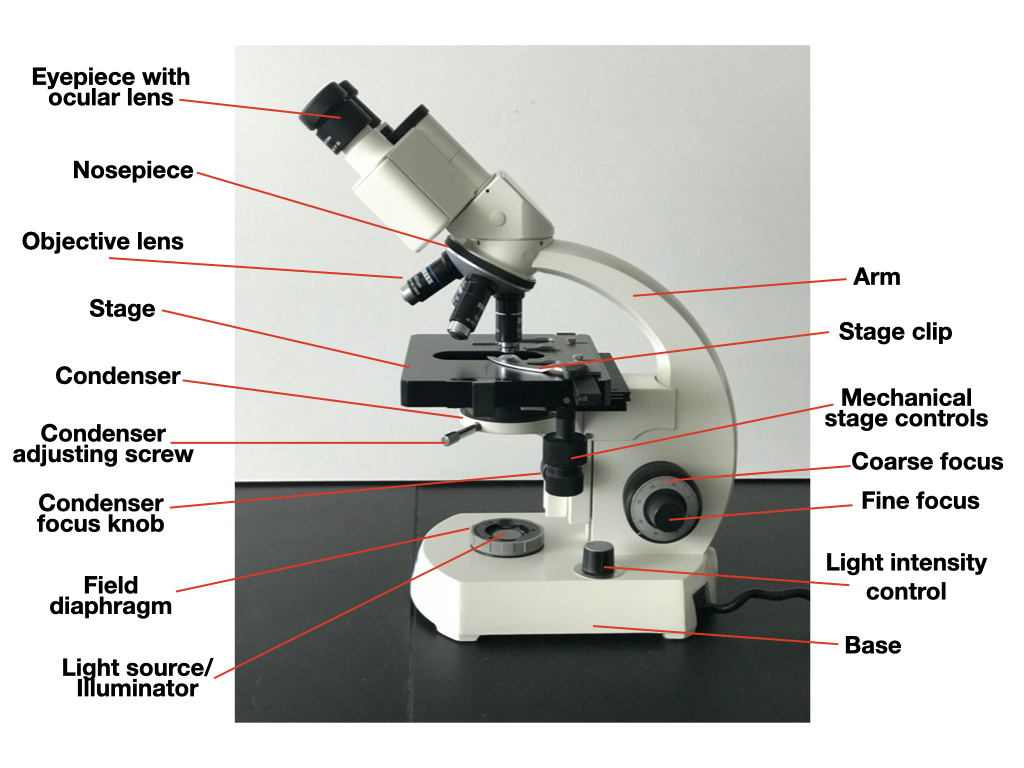3 Background: Introduction to Microscopes
A microscope is an instrument that magnifies an object so that it may be seen by the observer. Because cells are usually too small to see with the naked eye, a microscope is an essential tool in the field of biology. In addition to magnification, microscopes also provide resolution, which is the ability to distinguish two nearby objects as separate. A combination of magnification and resolution is necessary to clearly view specimens under the microscope. In this lab, parts of the microscope will be reviewed. Students will learn proper use and care of the microscope and observe samples from pond water.

“Parts of a microscope” by Melissa Hardy, Salt Lake Community College is licensed under CC BY-NC 4.0 / A derivative from the original work
A microscope magnifies the image of an object through a series of lenses. The condenser lens focuses the light from the microscope’s lamp onto the specimen. The light then passes through the object and is refracted by the objective lens. The objective lens is the more powerful lens of a microscope and is closest to the object. The light then travels to the ocular lens , which focuses the image onto the user’s eye. Usually, the power of the ocular lens is fixed for a given microscope.
Magnification
Your microscope has 4 objective lenses. On most of the student microscopes, these are 10x, 40x, 63x, and 100x (Oil Immersion). The number indicates the magnification, e.g., the 10x objective will magnify an object by 10 times. In addition to the objective lenses, the ocular lens (eyepiece) has a magnification.
The total magnification is determined by multiplying the magnification of the ocular and objective lenses. For instance, if the ocular lens has a magnification of 20x and the objective lens being used has a magnification of 4x, the total magnification will be 80x.
Resolution
The number after the magnification on an objective lens indicates the numerical aperture. This is a measure of the light-gathering ability of the objective lens. It is closely related to resolution. Resolution is the The higher the numerical aperture, the higher the resolution. A higher numerical aperture also means a shallower depth of field. It also requires a shorter working distance (i.e., you must get the objective lens closer to the specimen).
Resolution refers to the ability of a microscope to distinguish two points on the image. As resolution increases, objects that are closer together
appear as separate points. Contrast refers to the ability of a microscope to distinguish an object from its background. The higher the contrast, the greater the difference in intensity between an object and the background.
Resolution is also dependent upon the wavelength of light used to illuminate the specimen. Recall that the visible light spectrum (for humans) ranges from about 400 nm to 700 nm.

The visible light spectrum shown from shortest wavelength to longest wavelength. Humans can detect electromagnetic radiation as visible light between about 400 and 700 nanometers. (Figure is in the public domain).
Field of View
When you first place a specimen on the microscope’s stage, the image you see in the ocular lens will likely appear blurry. This is because light rays from the object are not reaching your eye at the same time. Focusing is used to improve the image. Focusing moves the stage up and down, which changes the point at which the light rays from the object converge. When the stage is at a position so that the light rays exactly converge on the retina of your eye, the image will appear sharp and clear.
When focusing the specimen, you must be careful! The distance between the objective and the specimen is very small, and it is possible to crush the specimen against the lens if you move the stage too far. The proper distance between the specimen and the object is called the working distance.
When you look at a specimen through the microscope’s lenses, you will likely not see the entire specimen at one time. Because the microscope enlarges the image of the object, only a small portion of the object will be visible at any given time. The field of view refers to the area that is seen through the ocular lenses.

